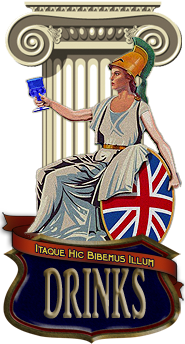 From Punch by David Wondrich
From Punch by David Wondrich
750ml Bols Genever
Peel of 1 Lemon
2 oz (by weight) of Demerara Sugar
8 oz plus 40 oz Boiling Water
Peel lemon, removing as little of the pith as possible
Combine lemon peel and sugar in heatproof bowl or pot, set aside for one hour
Add 8 oz boiling water to lemon and sugar, stir to dissolve sugar
Add genever, then add 32 oz of the remaining water (plus more to taste)
Keep punch warm on stove, by fire, or in a crock-pot
Yield: Approximately 9 Cups
* * *
“…Bob, turning up his cuffs — as if, poor fellow, they were capable of being made more shabby – compounded some hot mixture in a jug with Gin and lemons, and stirred it round and round and put it on the hob to simmer…”
Whether as sacrament or as celebration, drink has played an integral role in civilization since day one. Here at 12 Bottle Bar, our goal this holiday season has been to gather a collection of beverages that encourage festivity and communion among friends and family. In the case of the above quote, the “Bob” in question is Dickens’ own dear Bob Cratchit from ”A Christmas Carol” and the “hot mixture” is a Gin Punch he is brewing for the family’s Christmas dinner.
It’s unlikely that the poorly-paid Cratchit was pouring Gin of quality, but then, the British underclasses had been accustomed to a rougher style of the spirit since the early 18th Century. So, accept for a moment that 12 Bottle Bar is a Ghost of Christmas Past, and let us journey back to Londontown in the early 1700s to catch a glimpse of Gin’s darker, less festive side.
Drunk for a penny, Dead drunk for two, Clean straw for nothing.
18th Century Dram Shop Sign
Throughout history, no drink has been more synonymous with both the best and the worst that alcohol has to offer than Gin. The dram shop slogan above captures the Gin fever of the early 18th century when London was brought to its knees by a come-hither lass named Madame Geneva. That straw, by the way, wasn’t the drinking type, it was the sleeping kind, and indeed, for a significant portion of the 18th century (roughly 1720 to 1751), it seemed as if the vast majority of London was passed out on the floor. Frankly, the British poor – who suffered the most – didn’t have a chance. The stage had been set back in the 16th century during the Golden Ages of both Spain and England. The Spanish and British weren’t too fond of each other at this time – Sir Francis Drake kept himself busy sinking the Spanish Armada, while English troops, led by a chap named Robert Dudley, Earl of Leicester, sallied forth to the continent in support of the Dutch Protestant rebellion against the Spanish Catholic Hapsburgs. Dudley didn’t do so well, but his men did enjoy a nice little perk – they discovered something called “Dutch Courage”. Translation: Genever.
Another fellow who shared a taste for Genever (and a dislike of all things Catholic) was the Dutch-born William lll. Taking his first cousin-turned-wife in hand, William dethroned his Catholic, French-sympathizing uncle/father-in-law James II of England and, in 1686, set in motion the Glorious Revolution. Among other things, he banned French Brandy and made Genever fashionable. The timing couldn’t have been more perfect, as the English beer and ale-drinking public thirsted for a new national tipple.
By the early 1700s, Gin presented itself in a seductive package – it was far cheaper than beer or ale, it was much higher proof (thus more bang for the buck, or shilling as it were), and it was a novelty. Under the reign of William and Mary, wages were relatively high, which meant that the lower classes had some discretionary income. They spent it on Gin. Not the Tanqueray or Bombay of today, mind you – those were still to come – but grain spirits cut most often with turpentine and sulfuric acid. London distillers simply didn’t possess the knowledge, finesse, or morals to produce Dutch-style Genever. So, while the rich drank imported Dutch Gin, the poor were left with an ersatz and sometimes deadly substitute sporting the bastardized name of “Geneva” and, later, “Gin”.
Both Jessica Warner, in her book “The Gin Craze”, and David Wondrich liken this rotgut product (as well as its grip on the populace) to crack cocaine. Not only was the Gin roughly double the proof of today’s brands, it was being consumed like beer – by the tankard or the punch bowl. As Wondrich tells us, “Gin Punch is a combination of words that would have stuck Jonathan Swift and his contemporaries not unlike the way ‘Crack Martini’ strikes us today.”
Fortunately for us, modern day Gin is quite a different animal than its 18th century cousin. Indeed, by the early-to-mid 19th century, the new, modern styles of Gin were gaining some respectability. It was time for a Gin renaissance – a renaissance which came in the form of the Gin Palaces. The first palaces, which pandered to both poor and well-off alike, appeared around 1830. Some seven years before he would publish “A Christmas Carol”, Charles Dickens described the palaces in his “Sketches by Boz” thusly:
All is light and brilliancy … the gay building with the fantastically ornamented parapet, the illuminated clock, the plate-glass windows surrounded by stucco rosettes, and its profusion of gas-lights in richly-gilt burners, is perfectly dazzling when contrasted with the darkness and dirt we have just left. The interior is even gayer than the exterior. A bar of French-polished mahogany, elegantly carved, extends the whole width of the place; and there are two side-aisles of great casks, painted green and gold, enclosed within a light brass rail.
Given the period that Dickens wrote “A Christmas Carol”, it is likely that Bob Cratchit’s poor man’s Gin Punch featured Old Tom Gin – an inexpensive, sweetened botanical style sold in the Gin Palaces that laid the foundation for the modern London Dry Gins. According to Wondrich via a description left by American comedian Howard Paul, the well-heeled Dickens would have made his hot Gin Punch from “old gin”, which may have been either Dutch or English, as Dickens kept both in his cellar.
The recipe provided here should be considered a template for almost any hot punch. The chief difference between hot and cold punches is the use of lemon juice. Most simple hot punches do not call for it (Charles Dickens’s Punch being an exception). Whiskey is as just as traditional and tasty here. As are Brandy and, in some cases, Rum. Pot-still, higher proof spirits will stand up to the water better than weaker ones – most of all, you’re looking for something that doesn’t drown beneath the weight of the H20. A grating of nutmeg is not specifically called for, but if you’re so inclined, we won’t stop you. The recipe is flexible; simply add the amounts of water and sugar that you like. As with most punches, this is a subtle drink, a far cry from the alcohol bomb of the cocktail. In fact, it is the exact opposite – but be careful, there’s as much alcohol in a glass of punch as in a mixed drink. This Gin Punch, as made with Bols Genever, shows at a fundamental level how simple ingredients – spirits, water, sugar, and citrus — when properly balanced, can produce a perfect beverage. Now only does hot Gin Punch taste delicious, it slowly co-mingles with the bloodstream and warms you on a cellular level.
In the spirit of the season, we think it’s high time that Bob Cratchit and family got a de facto upgrade to proper Genever – after all, the poor lot has been suffering at the hands of Scrooge for some 167 years. So, today we drink with the Cratchits – with Bob and Tiny Tim and the entire family – and it is to them that we raise our glasses in celebration of the season with a toast of “God bless us, every one!”
Related Articles
- Today’s drinking event: What Dickens Drank (timeoutny.com)
- A Touch of Dickens: Tanqueray Finest Gin Punch (luxist.com)









































Fun bit of trivia there with the Dram Shop Sign. Another great post.
Funny, I know most of your lovely history in a sort of fuzzy way… you have sharpened my focus utterly. I must try genever gin one of these days…it is a little sweet, yes?
I am really new to the mixed drink after years of drinking nothing but grape. Really super job on the post… although you didn’t mention that babies were given gin to shut them up… no wonder they were sickly, can you imagine??? I am making my gin drink this week… can’t wait!!!!
Deana — have to admit that my main resource for this one was Lesley’s forthcoming book “Gin: A Global History” (Spring 2012). The gin babies are in there.
Old Tom is the “sweet” gin. Genever is malted, thus making it more akin to a light whiskey — a whiskey with juniper. I think you’d love it. The Bols is really approachable. Anchor Distilling’s Genevieve is more like mescal in its funkiness but brilliant in drinks.
Thanks for the compliments.